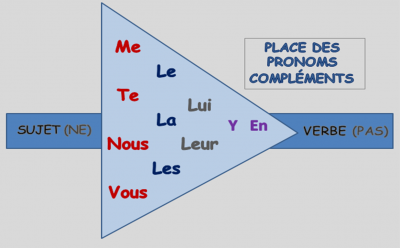
Les pronoms COD et COI
COD (Complément d’Objet Direct)
COD (Complément d’Objet Indirect)
We use the COD pronouns (me, te, le, la, nous, vous and les) when the person or the object comes directly after the verb.
E.g. Il regarde Marie → Il la regarde
We use the COI pronouns (me, te, lui, nous, vous and leur) when the person or the object comes after a verb and a preposition (e.g. à)
E.g. Il parle à Marie → Il lui parle
When we use the preposition ‘à’, and then put a place or a thing after it, we use the pronoun ‘y’.
E.g. Elle pense à sa santé → Elle y pense
When we use the preposition ‘de’, and then put a thing or a certain quantity or of something, we use the pronoun ‘en’.
E.g. Elle mange une pomme → Elle en mange une
It’s possible to use more than one pronoun in a single sentence.

The order of pronouns is shown above. This is a very important rule to follow as otherwise your sentence will be wrong.
Les pronoms COD et COI
COD (Complément d’Objet Direct)
COD (Complément d’Objet Indirect)
We use the COD pronouns (me, te, le, la, nous, vous and les) when the person or the object comes directly after the verb.
E.g. Il regarde Marie → Il la regarde
We use the COI pronouns (me, te, lui, nous, vous and leur) when the person or the object comes after a verb and a preposition (e.g. à)
E.g. Il parle à Marie → Il lui parle
When we use the preposition ‘à’, and then put a place or a thing after it, we use the pronoun ‘y’.
E.g. Elle pense à sa santé → Elle y pense
When we use the preposition ‘de’, and then put a thing or a certain quantity or of something, we use the pronoun ‘en’.
E.g. Elle mange une pomme → Elle en mange une
It’s possible to use more than one pronoun in a single sentence.

The order of pronouns is shown above. This is a very important rule to follow as otherwise your sentence will be wrong.
 Knowt
Knowt
